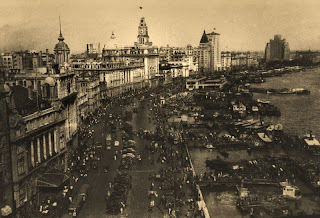
We all have heard about leading music label companies such as EMI (Electric Music Industries), BMG, Sony Music, Columbia Records, Polydor, etc.
In Shanghai, the first music ever arrived was in the 1900's when two Frenchmen came to the bund, and played a piece of record (produced by Pathe, France), and the contents of the record was made meant to make people laugh. This sort of entertainment is made on a bet-purchase-basis. In order to listen to this music, one has to pay 5 cents (if i am not mistaken) and if you are able to resist your laughter, then you will be entitled to a refund.
(top: chinese pathe label logo; bottom: a typical pathe label on a 78rpm)
Later, in the 1910's, Pathe then became a recording company for most opera shows, producing chinese opera 78 rpms, and to have the marketed outside. Pathe is well known for it's cock-figure design, which was initially in red colored fat-oversized cock. It was called as Shanghai Bai Dai Kong Si (Shanghai Pathe Company) which could be found on all labels.


 (middle top to bottom: chow hsuan's LP record produced in 1958, with the picture of a cock in morning sunrise; Shanghai Pathe record label in the 1930's; Disque Pathe de Shanghai in the 1910's)
(middle top to bottom: chow hsuan's LP record produced in 1958, with the picture of a cock in morning sunrise; Shanghai Pathe record label in the 1930's; Disque Pathe de Shanghai in the 1910's)In the 1930's, Pathe then decided to invite exclusive artists to produce recordings of popular folk songs, as well as modern popular jazz scores. Artists such as Chow Hsuan 周璇 , Yao Lee (a.k.a. Hwee Lee), and Bai Hung were the artists which came into existence in the 1930's.
Chow Hsuan 周璇
- Born in 1918, she has spent her lifetime searching for her parents. She was adopted with the name Su Pu. In 1935, she made her first debut in the movie: Street Angel, and her first popular hit Tian Ya Ge Nu and Se Ji Ge. She has produced over 200 songs, and a large number of movies, until her death in 1957 due to encephilites. She had a pitiful history of dishonest husbands, which led her to suffer from mental conditions. She is known today as the most famous Shanghainese female singer icon, with her evergreen popular tune "Ye Shanghai" - Night in Shanghai
Yao Lee
- Miss Hwee Lee has produced over 400 records, and her most popular score would be Mei Gui Wo Ai Ni (the popular English title: Rose, Rose I love you) She has a unique voice, both sweet and smooth. She is known as the Chinese version of Patti Page.
Bai Hung
- Famous for her "hippy tune" producing numerous records with tango tunes, she started her stardom in a singing competition in Shanghai in 1934 and became well known in the 1930's - 1950's for her dance-style music.
 (Top: Chinese Pathe advertisement for an exclusive artiste)
(Top: Chinese Pathe advertisement for an exclusive artiste)The Chinese Pathe Company is then taken over by the EMI (Electric Music Industries in the 1960's and now is a subsidiary company of the EMI. Chinese Pathe is still existent today, and it reproduces the original recordings and works of the aritistes in the 1930's - 1970's in CD format.
My collection today holds around 50 Pathe Recordings on 78 rpm, and 10 others on LP format.














 (middle top to bottom: chow hsuan's LP record produced in 1958, with the picture of a cock in morning sunrise; Shanghai Pathe record label in the 1930's; Disque Pathe de Shanghai in the 1910's)
(middle top to bottom: chow hsuan's LP record produced in 1958, with the picture of a cock in morning sunrise; Shanghai Pathe record label in the 1930's; Disque Pathe de Shanghai in the 1910's)








